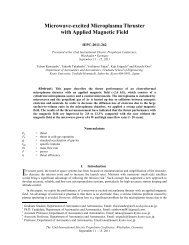Design Development and Test of the RIT-ÁX Mini Ion Engine System
Design Development and Test of the RIT-ÁX Mini Ion Engine System
Design Development and Test of the RIT-ÁX Mini Ion Engine System
You also want an ePaper? Increase the reach of your titles
YUMPU automatically turns print PDFs into web optimized ePapers that Google loves.
In ion thruster technology <strong>the</strong> rf-principle is unique, but <strong>the</strong>re exists a broad field <strong>of</strong> applications where rfionization<br />
is used. It is employed in plasma- <strong>and</strong> ion sources for material processing (solid state physics,<br />
semiconductors, plasma chemistry…) as well as for neutral injector sources for fusion plasma heating. So <strong>the</strong><br />
physics behind are well understood. Some special properties, which also apply for ion thrusters, make <strong>the</strong> RFplasma<br />
very favourable for propulsion purposes <strong>and</strong> especially for micro propulsion.<br />
B. Physical Background<br />
High Discharge Efficiency: The plasma generation by RF is one <strong>of</strong> <strong>the</strong> most efficient methods to set a gas in <strong>the</strong><br />
ionized plasma state. The efficiency is so high that no additional support, like external magnetic fields for plasma<br />
confinement is required. RF-thrusters work without permanent magnets or additional solenoid.<br />
Low Electron Temperature: [5][6]The plasma’s electron temperature is comparably lower than for Kaufman<br />
thrusters. Therefore <strong>the</strong> potential drop, which in a first order is directly proportional to <strong>the</strong> electron temperature,<br />
between <strong>the</strong> quasi neutral inner plasma <strong>and</strong> its surroundings remains below <strong>the</strong> sputter thresholds <strong>of</strong> <strong>the</strong> materials<br />
used for <strong>the</strong> ionisation chamber <strong>and</strong> <strong>the</strong> screen grid. Nei<strong>the</strong>r <strong>the</strong> plasma sided grid nor <strong>the</strong> ionisation chamber are<br />
subject to any kind <strong>of</strong> erosion processes.<br />
Beam<br />
Neutralisation<br />
<strong>Ion</strong><br />
Production<br />
<strong>Ion</strong><br />
Acceleration<br />
Acceleration<br />
<strong>RIT</strong>-µX <strong>Ion</strong> Thruster<br />
A = Acceleration Grid<br />
S = Screen Grid<br />
Io = <strong>Ion</strong>isation Chamber<br />
Neut = Neutraliser<br />
Ins = Gas Inlet <strong>and</strong> isolator<br />
Rf = Radio Frequency Generator<br />
Figure 1 Operating Principle <strong>of</strong> an RF-<strong>Ion</strong> Thruster <strong>and</strong> <strong>RIT</strong>-µX elegant breadboard.<br />
Low amount <strong>of</strong> multiply charged ions: [5] The power to thrust ratio <strong>of</strong> any gridded ion engine is increased, if<br />
multiple charged ions occur in <strong>the</strong> ion beam. A low electron temperature means a very small amount <strong>of</strong> multiple<br />
charged ions in <strong>the</strong> ioniser <strong>and</strong> <strong>the</strong> ion beam. The low amount (typ.






